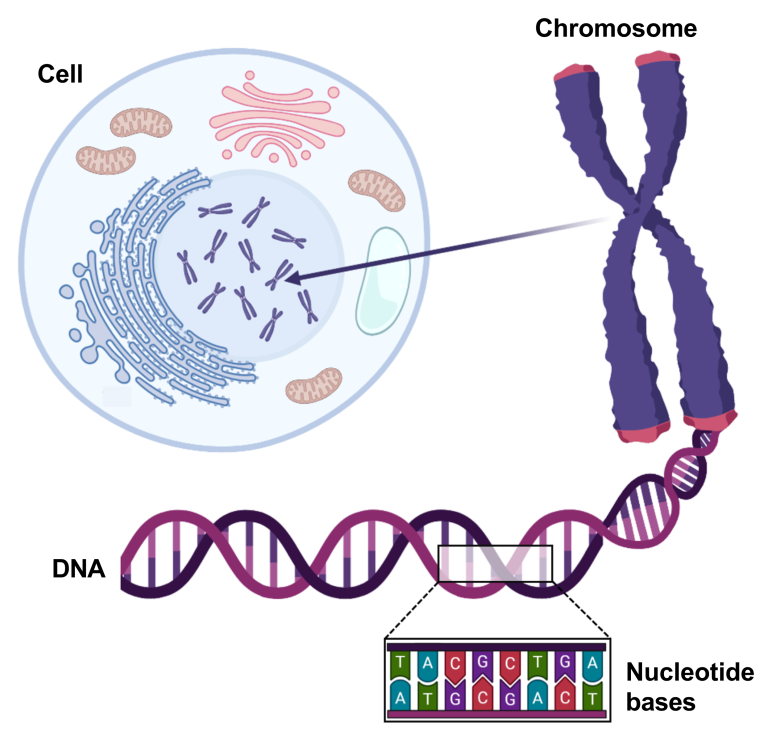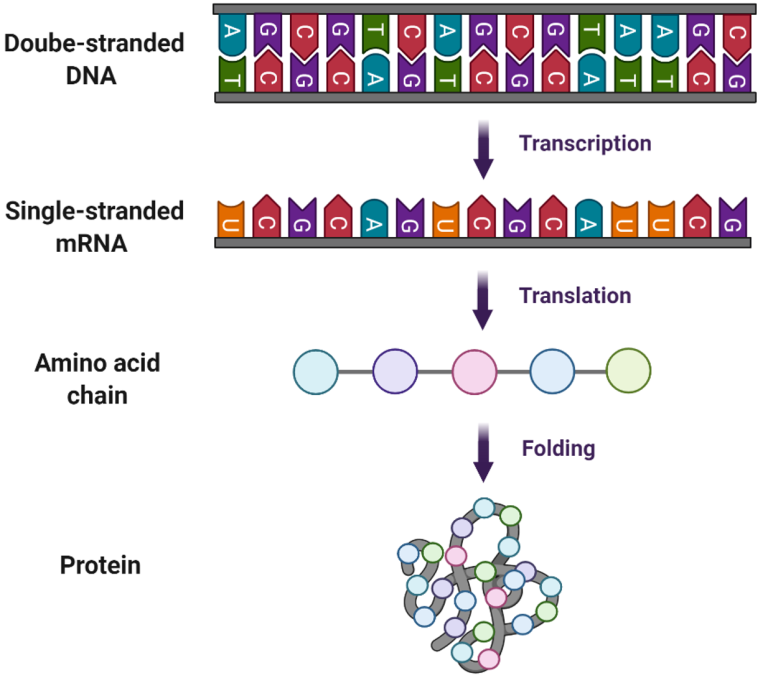A gene is the basic physical unitof heredity. Every living cell contains genetic information that determines an organism’s development, form, and function. This genetic information is encoded by two macromolecules: DNA and RNA.
DNA consists of two strands of phosphate and sugar molecules connected by pairs of nitrogenous bases to form a double helix structure. The four nitrogenous bases in DNA are adenine, thymine, cytosine, and guanine (abbreviated A, T, C, and G). Genes are sequences of nucleotides (composed of a sugar, a phosphate group, and a base) that provide the instructions that cells need to make molecules that give rise to an organism’s characteristics. Within the nucleus of each cell, DNA is tightly coiled around specialized proteins called histones, forming compact structures called chromosomes. Each gene occupies a particular position, or locus, on a chromosome.

Most genes contain instructions for creating proteins, amino acid-based macromolecules with a wide range of structures and functions. Among their numerous essential functions, proteins contribute to cell structure and repair, signal transmission between cells, and biochemical reactions within cells. Genes are used to create proteins through a two-step process. Double-stranded DNA is first transcribed into single-stranded messenger RNA (mRNA) that serves as a template for protein synthesis. mRNA exits the nucleus and interacts with cellular machinery called ribosomes. Ribosomes then read mRNA and translate its nucleotide sequence into long chains of amino acids, which then fold to form proteins.

An organism’s complete set of genetic material is called a genotype. The human genome is estimated to contain between 20,000 and 25,000 protein-coding genes, varying in size from thousands of nucleotides to over 2 million nucleotides. The complete set of observable traits that results from gene expression is called a phenotype. An organism’s phenotype includes all of its outward characteristics, including height and eye colour, as well as less apparent characteristics such as blood group and intelligence. For example, the genes that determine the amount of pigment in my skin are part of my genotype, but my skin colour is part of my phenotype. Whereas one’s genotype is determined solely by biological factors, one’s phenotype is determined by complex interactions between biological and environmental factors. This distinction between genotype and phenotype is evident in the case of identical twins – even though they have the same genotype, they often look and behave differently due to environmental and lifestyle factors.
Genes and Heredity
Heredity is the transmission of genes and traits from one generation to the next. Nearly all human cells have 23 pairs of chromosomes. Egg and sperm cells are unique in that they only have one set of 23 chromosomes. We inherit one set of chromosomes from our mother’s egg and the other set from our father’s sperm, yielding two copies of each gene. The exception to this is a small set of genes that are unique to the X and Y chromosomes, which determine an organism’s sex.
Variants of genes that differ slightly in nucleotide sequence are called alleles. An individual with two copies of the same allele is said to be homozygous for the corresponding gene. Conversely, an individual with two different alleles for a given gene is said to be heterozygous for that gene. Dominant alleles are alleles for which a single copy is sufficient to result in a particular trait; the trait will be expressed in a heterozygote. Recessive alleles are alleles for which two copies are required for the corresponding trait to manifest; recessive alleles are masked, or hidden, by their dominant counterparts in a heterozygote. Most traits are polygenic, meaning that they are determined by the expression of multiple genes.
Genetic Diseases and Ataxia
Permanent changes in DNA sequence called mutations can be inherited or acquired and can affect one or multiple genes. A genetic disease is a disease caused by an inherited change in an organism’s DNA sequence. Scientists now believe that most disorders have a genetic component.
Many forms of ataxia are hereditary, resulting from gene mutations and the creation of faulty proteins. In hereditary ataxias, these proteins impair the function of neurons in the cerebellum and spinal cord, resulting in clinical symptoms such as impaired balance and coordination. Ataxias resulting from dominant genes include the spinocerebellar ataxias (SCA1 through SCA37). Ataxias resulting from recessive genes include Friedreich’s ataxia and ataxia-telangiectasia.
As we advance our understanding of genetics, we can better understand and treat complex genetic conditions such as hereditary ataxias. We can also apply an understanding of genetics to improve our general health. Given the intimate interaction between genes and the environment, we can modify our lifestyle factors and activities based on our genetics to improve our health and quality of life. For example, someone with a genetic predisposition to heart disease may choose to adopt a low cholesterol diet. Similarly, someone who has inherited a genetic ataxia may choose to engage in exercises that improve coordination and balance.
To learn more about genes and heredity, check out these articles and videos from Basic Biology, Medline Plus, and TED-ed.
Snapshot written by Dr. Chloe Soutar and edited by Celeste Suart.
Social Media featured image is “DNA” by MIKI Yoshihito on Flickr.










